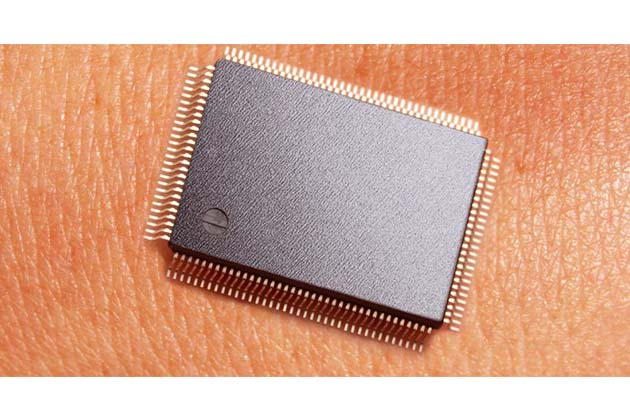The discovery of a new type of malleable, self-healing and completely recyclable “electronic skin” has wide applications in health monitoring, robotics, prosthetics and improved biomedical devices.
A study published in Science Advances showcases a new electronic skin (or simply e-skin) that has multitude of properties including malleability, self-healing and full recyclability when compared to the human skin1.The skin, our largest organ, is the fleshy covering when seen from outside. Our skin is a highly versatile organ which acts as a waterproof, insulating shield and guards our body from a variety of external dangers or factors e.g. damaging sun. Some of the functions of skin is regulation of body temperature, protection of body from intake of toxic substances and also excretion of toxic substances (along with sweat), mechanical and immunological support and production of the crucial vitamin D which is very important for our bones. Skin is also a huge sensor with ample nerves to instantly communicate with the brain.
Researchers worldwide have been working on developing different types and sizes of ‘wearable e-skins’ with the goal of trying to mimic biological skin and its various functions. There is a strong need for flexible and stretchable devices for seamless integration with soft and curvilinear human skin. Nanoscale (10-9m) materials can provide the required mechanical and electrical versatility replacing the rigid silicon which has usually been used before. The team led by Dr. Jianliang Xiao at the University of Colorado, Boulder, USA have successfully developed an artificial electronic skin (e-skin) with the goal of translating sensory touch of the human skin onto robots and prosthetics. This attempt is in the direction of having a “wearable” technology in the future which would have huge potential and value in medical, scientific and engineering fields.
E-skin: self-healing and recyclable
E-skin is a thin, translucent material having a novel type of covalently bonded dynamic polymer network, called polyimine, which is laced with silver nanoparticles for improved mechanical strength, chemical stability and electrical conductivity. This e-skin also has sensors embedded in it to measure pressure, temperature, humidity and air flow. This e-skin is being considered remarkable because it has been incorporated with many features which make it an extremely closer mimic of the human skin. It is highly malleable and can be easily set onto curved surfaces (e.g. human arms and legs, robotic hands) by applying moderate heat and pressure to it without introducing excessive stresses. It has amazing self-healing properties wherein upon any cut or damage caused by an external circumstance, the e-skin recreates the chemical bonds between the two separated sides restoring the matrix for its proper functionality and returning to its original bonded state.
If this e-skin becomes unusable due to any circumstance, it can be completely recycled and turned into a brand-new e-skin by placing it in a recycling solution that “liquifies” the existing e-skin material and turns it into a “new” e-skin. This recycling solution – a mixture of three commercially available chemical compounds in ethanol – degrades polymers and silver nanoparticles sink at the bottom of the solution. These degraded polymers can be used afresh to make new functional e-skin. This self-healing and recyclability which is attainable at room temperature is attributed to the chemical bonding of the polymer used. The advantage of polymeric network of polyimine is that its reversible and can be broken and recycled unlike most conventional thermostat materials which can neither be reshaped or reprocessed or recycled because of the irreversible bonds within their cross-linked polymeric networks. This is more robust than human skin itself and it could be used as an enhancement to it rather than replacement. It is also pleasant to touch and feels almost like real skin which could possibly make it as a covering agent in the future, of say electronic devices.
Eco-friendly and low on cost properties of e-skin have been hailed and such e-skin could greatly reduce electronic waste and environmental impact and could be highly usable and popular with manufacturers across different fields. Though it may sound farfetched at the moment, this reuse technology could also be similarly applied to old electronics items as well. In fact, modern day fitness trackers and health monitors once damaged add to the growing mountain of e-waste compounding environment related problems. The e-skin could be worn around our necks or on our wrists and these could be like flexible wearables or temporary tattoos and whenever they get damaged they can be recycled and reused. Since e-skin is flexible, it can be bent and twisted and can be made customized according to the wearer. The technology opens up avenues for intelligent robotics in which such a pleasant to feel and confortable electronic skin can be wrapped around the body of a robot or an artificial limb. To elaborate, a prosthetic arm or leg which is wrapped in this electronic skin can allow the wearer to respond to temperature and pressure changes because of the multiple sensors incorporated in it. The robotics arms or legs fitted with such an e-skin can make the robots act more delicately towards humans and be more safe and reliable. For example, e-skin could be specifically fitted to a robot handling a baby or a fragile elderly and thus robot will not be applying too much force. Another application of e-skin can be potentially in hazardous environments or high-risk jobs. It is plausible that this technology could be used with virtual buttons, controls or doors that would enable any operation without human physical interaction, for example in explosives industry or other dangerous lines of work, and thus this e-skin maybe able to decrease the chances of any human injury.
Adding display to e-skin
A team of researchers at University of Tokyo have recently added a display2(micro-LED) to ultrathin, band aid-style e-skin patches to enable display of different signs of health monitoring in real time (e.g. measuring glucose levels in people with diabetes or the moving waveform of an electrocardiogram of a heart patient). These patches have a stretchable wiring and thus can bend or stretch to up to 45 precent based upon the movement of the wearer. These are considered as having the most flexible and durable design in recent times. The continuous shedding of human skin cells could mean that the patch might fall off after a few days but this can be worked around.
This study, led by Professor Takao Someya states that such a display can be eventually used to enable reading and communicating medical information in a seamless and easy manner not only for patients but also for family members, care givers and health professionals either in person or even remotely. It would receive messages as well. The researchers aim to further improve the reliability of the patch, make it more cost effective and also increase its production for a wider reach around the globe. Their goal is to launch this device in the market by the end of 2020.
Challenges ahead
The development of e-skin is a very exciting novel research, however, one of the fundamental properties of our – flexibility and stretch ability – is yet to be successfully achieved by e-skin. The e-skin is soft but not as stretchy as human skin. According to the authors, as it stands the material is also not very easily reproducible. A slight reduction in the overall sensing performance in a rehealed/recycled e-skin device was seen compared to a fresh module, this needs to fully addressed with further research. The magnetic fields used by e-skins are also quite high and need to be scaled down. Currently the device is powered from an external source which is very impractical, but it should be possible to have rechargeable, small batteries to power the device instead. Dr.Xiao and his team want to refine this product and improve scaling solution so that at least the economic hurdles can be surpassed and this e-skin should be easier to manufacture and place on robots or prosthetics or medical devices or anything else.
***
{You may read the original research paper by clicking the DOI link given below in the list of cited source(s)}
Source(s)
1. Zou Z et al. 2018. Rehealable, fully recyclable, and malleable electronic skin enabled by dynamic covalent thermoset nanocomposite. Science Advances. https://doi.org/10.1126/sciadv.aaq0508
2. Someya T. 2018. Continuous Health-Monitoring With Ultraflexible On-Skin Sensors. AAAS Annual Meeting Symposium, Austin, Texas, February 17, 2018.




































